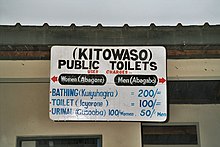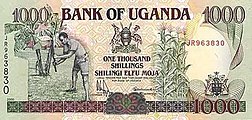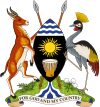|
Ugandan shilling
The shilling (Swahili: shilingi; abbreviation: USh; ISO code: UGX) is the currency of Uganda. Officially divided into cents until 2013, due to substantial inflation the shilling now has no subdivision.[1] Notation Prices in the Ugandan shilling are written in the form of This pattern was modelled on sterling's pre-decimal notation, in which amounts were written in some combination of pounds (£), shillings (s), and pence (d, for denarius). In that notation, amounts under a pound were notated only in shillings and pence. HistoryThe first Ugandan shilling (UGS) replaced the East African shilling in 1966 at par. Following high inflation, a new shilling (UGX) was introduced in 1987 worth 100 old shillings. The shilling is usually a stable currency and predominates in most financial transactions in Uganda, which has a very efficient foreign exchange market with low spreads. The United States dollar is also widely accepted. Sterling and increasingly the euro are also used. The Bank of Uganda cut its policy rate to 22% on 1 February 2012 after reduction of inflation for 3 consecutive months.[2] CoinsFirst shillingIn 1966, coins were introduced in denominations of -/5, -/10, -/20 and -/50 and 1/= and 2/=. The -/5, -/10 and -/20 coins were struck in bronze, with the higher denominations struck in cupro-nickel. The 2-shilling was only issued that year. In 1972, cupro-nickel 5-shilling coins were issued but were withdrawn from circulation and are now very rare. In 1976, copper-plated steel replaced bronze in the 5- and 10-cent and cupro-nickel-plated steel replaced cupro-nickel in the 50-cent and 1-shilling. In 1986, nickel-plated-steel 50-cent and 1-shilling coins were issued, the last coins of the first shilling.
Second shillingIn 1987, copper-plated-steel 1/= and 2/= and stainless-steel 5/= and 10/= coins were introduced, with the 5/= and 10/= curved-equilateral heptagonal in shape. In 1998, coins for 50/=, 100/=, 200/= and 500/= were introduced. Denominations currently circulating are 50/=, 100/=, 200/=, 500/=, and 1,000/=.[3]
BanknotesFirst shillingIn 1966, the Bank of Uganda introduced notes in denominations of 5/=, 10/=, 20/= and 100/=. In 1973, 50/= notes were introduced, followed by 500/= and 1,000/= in 1983 and 5,000/= in 1985.[citation needed] Second shillingIn 1987, notes were introduced in the new currency in denominations of 5/=, 10/=, 20/=, 50/=, 100/= and 200/=. In 1991, 500/= and 1,000/= notes were added, followed by 5,000/= in 1993, 10,000/= in 1995, 20,000/= in 1999, 50,000/= in 2003 and 2,000/= in 2010. Banknotes currently in circulation are 1,000/=, 2,000/=, 5,000/=, 10,000/=, 20,000/= and 50,000/=. In 2005, the Bank of Uganda was considering whether to replace the low-value notes such as the 1,000/= with coins. The lower denomination notes take a battering in daily use, often being very dirty and sometimes disintegrating.[4] On 17 May 2010, the Bank of Uganda issued a new family of notes featuring a harmonised banknote design that depict Uganda's rich historical, natural, and cultural heritage. They also bear improved security features. Five images appear on all the six denominations: Ugandan mat patterns, Ugandan basketry, the map of Uganda (complete with the equator line), the Independence Monument, and a profile of a man wearing Karimojong headdress. Bank of Uganda Governor Emmanuel Tumusiime Mutebile said the new notes did not constitute a currency reform, nor were they dictated by politics. The redesign, he said, was driven by the need to comply with international practices and to beat counterfeiters. Uganda is the first African country to introduce the advanced security feature SPARK[5] on a regular banknote series. SPARK is an optical security feature recognised by central banks worldwide and is used on a number of banknotes for protection against counterfeiting. Current notesAs of April 2023, these are the Ugandan shilling banknotes in circulation:[6]
Exchange rates
See alsoReferences
|
|||||||||||||||||||||||||||||||||||||||||||||||||||||||||||||||||||||||||||||||||||||||||||||||||||||||||||||||||||||||||||||||||||||||||||||||||||||||||||||||||||||||||||||||||||||||||||||||||||||||||||||||||||||||||||||||||||||





